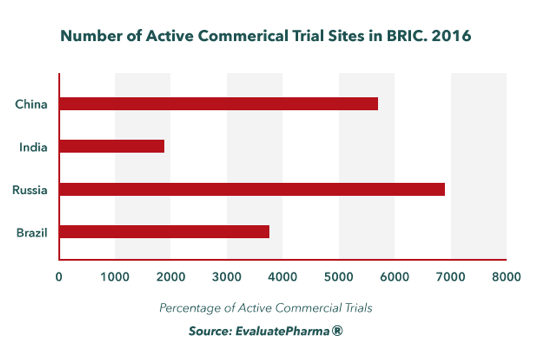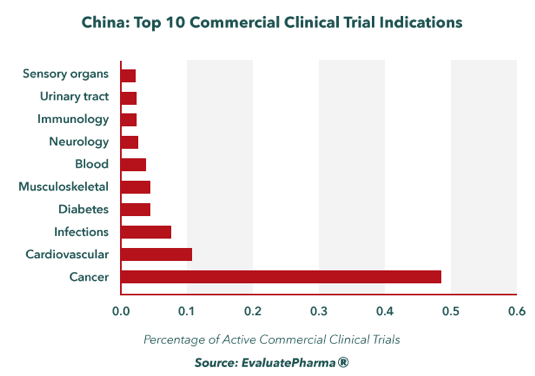Clinical Trials Status in BRIC
With North America and Europe accounting for the majority of active clinical trial sites in 2016, the need for globalization is increasing. Brazil, Russia, India and China are emerging markets with potential, but not without challenges.
The clinical trials sector remains dominated by North America and Europe, collectively accounting for over 80% of active commercial clinical trial sites in 2016. However, increasing need for globalization has led to clinical trials being conducted in a wider number of countries, in particular emerging regions. In 2006, commercial clinical trials were conducted in 92 countries. To date, this number has increased to 140; growth of over 50%. The emerging regions of South America, Middle East and Asia (excluding Japan) currently account for just under 10% of all commercial clinical trial sites globally. Although they remain regions of interest due to large treatment naïve patient pools, faster recruitment rates and lower costs, conducting trials in these markets is not without its challenges. Focusing on the core BRIC (Brazil, Russia, India and China) markets, this article highlights some of the key challenges in conducting clinical trials in emerging markets. Brazil Regulatory barriers present a significant challenge for conducting clinical trials in Brazil. The National Health Surveillance Agency (ANVISA) process is lengthy, costing pharmaceutical companies valuable time and money, which has deterred companies from conducting trials in the country. In response to this, the ANVISA reviewed the process to take into account previous approval from other regulatory bodies in an effort to streamline the process for multinational sponsors. Currently, there is estimated to be just under 4,000 active clinical trial sites in Brazil, ranking it third out of BRIC markets, behind Russia and China. Clinical trials in oncology account for over 30% of trials currently running in Brazil, significantly more than any other indication. According to the World Health Organization, ischaemic heart disease is the leading cause of death in Brazil1. However, clinical trials in cardiovascular indications are estimated to account for less than 10% of active clinical trials. Although further growth is anticipated as regulatory processes are amended, resulting in improved return on investment, the current economic climate in Brazil will act as an additional barrier in the short term. The OECD forecasts that the current recession will continue through 2016 into 20172 inevitably impacting healthcare investment and stalling further regulatory reforms for the clinical trials sector.

Russia As part of Russia’s 2020 strategy there has been an increased focus on the local manufacture to reduce reliance on imports. In addition to other industries, the pharmaceutical market has been impacted by this with multinational sponsors looking to partner with local suppliers and invest in local production in order to remain competitive in the market. Russia is currently ranked 10th globally based on the number of commercial clinical trials sites with just under 7,000 in 2016. There are estimated to be over 800 clinical trials currently active in Russia, of these there is a substantial weighting towards Phase III trials, with nearly 60% of clinical trials currently running in Russia in Phase III. This is likely due to the high cost associated with phase 3 trials driving European sponsors to invest in clinical trials in Eastern Europe and Russia in order to reduce costs. Increased knowledge of the drug during Phase III also gives sponsors more flexibility to conduct trials in standard healthcare facilities in a variety of countries compared to Phase I research which remains limited to specialist clinics in developed markets. In fact, only 5% of clinical trials currently running in Russia are in Phase I or Phase I/II. Forecasts for the Russian clinical trials market are mixed. Increased investment in healthcare and regulations has improved clinical trial quality. Although data and quality have increased, rapidly changing regulations and corruption remain concerns for multinational suppliers. India According to the World Bank, approximately 67% of the Indian population live in rural areas3. Healthcare provision in rural areas remains poor and as a result a high proportion of the population have to travel long distances to receive basic medical services and partake in clinical trials. Although healthcare expenditure as a proportion of GDP has increased in India, it remains low compared to other countries and out-of-pocket payments are high in order to subsidise public healthcare services. The quality of care provided in healthcare facilities also varies, creating a challenge for clinical trial sponsors to ensure that facilities are adequate for conducting trials. Furthermore, despite efforts by the Central Drugs Standard Control Organization (CDSCO) to improve infrastructure to support clinical trials, an analysis by the World Health Organization highlights the numerous regulatory and ethical concerns regarding the conduct of clinical trials in India4. As a result, the number of active commercial clinical trial sites in India has decreased over the last five years, estimated at 1,884 in 2016. The current clinical trial landscape in India is dominated by multinational suppliers, although the volume of clinical trials conducted is low. Based on the current clinical trials pipeline, Boehringer Ingelheim was ranked first, closely followed by NovoNordisk, Novartis, Eli Lilly and AstraZeneca in the top five. Increasing incidence of chronic diseases including diabetes, cancer and cardiovascular disease have made these indications a focus of clinical trials. Cancer, diabetes and cardiovascular indications were all ranked within the top five based on the number of clinical trials currently active. Interest in conducting clinical trials in India will continue, however minimal growth is expected as sponsors remain cautious of conducting trials in the region.

China Research by IMS Health estimates that within the next two years China will become the second largest pharmaceutical market globally; surpassed only by the United States. Robust annual GDP growth (6.9%)5 has resulted in strong investment in healthcare. The launch of the Major New Drug Innovation Program (MNIP) has seen significant investment in drug development. High incidence of cancer has meant particular investment in oncology trials. Nearly half (48%) of active commercial clinical trials in China are for oncology indications. Within this there is focus on lung, liver, breast and stomach cancer, accounting for 47% of commercial oncology trials currently active. The MNIP has also supported the development of domestic pharmaceutical companies. In fact, based on the number of clinical trials currently active the leading sponsor in China is Jiangsu Hengrui Medicine, closely followed by multinational sponsor Novartis. Two of the top 10 commercial clinical trial sponsors in 2016, are domestic sponsors, creating further competition for multinational companies. Although local sponsors have experienced strong growth, multinational pharmaceutical companies still dominate the top 10 with Novartis, Bayer, AstraZeneca and Johnson & Johnson within the top five based on the number of clinical trials currently active. As of June 2016, China was ranked 13th globally with an estimated 5,628 commercial clinical trial sites. However, the 2014 GSK corruption case, which saw the drug maker heavily fined for bribery, has resulted in stricter regulations for the pharmaceutical and medical device industries as part of the government’s anti-corruption campaign. This is projected to create a more stringent and challenging regulatory environment for pharmaceutical companies, which could lengthen time to market.

Long term investment needed? Economic uncertainty, regulatory barriers and clinical trial quality are key concerns for the conduct of trials in emerging markets. Expansion of clinical trials into emerging regions requires detailed understanding of country specific dynamics in order to fully realise the benefits on offer. Currently most emerging countries require additional investment to improve healthcare facilities, training and regulations to ensure that all aspects of the healthcare infrastructure are able to support the complex practicalities of running a clinical trial. Given the variety of challenges currently faced in emerging markets sponsors may not be able to use a ‘one size fits all’ approach by running clinical trials in the same way as in developed markets. Therefore, in the short term many pharmaceutical companies may choose to invest in training and partnerships with local clinics or non-profit organisations before committing fully to the conduct of trials in emerging regions. Furthermore, alternative clinical trials models, processes or training methods may need to be considered to allow greater flexibility and improve engagement in trials in emerging countries. Although challenging, successful, widespread implementation of clinical trials in emerging markets are important for both the pharmaceutical industry and the populations living there. The benefits will undoubtedly be realised as healthcare systems mature and modernize. However, in a sector already conscious of escalating costs and focused on minimising risk, expansion into emerging regions may be a chance many sponsors are currently unwilling to take. Author’s Note: This article has been written based on EvaluatePharma® clinical trial data. All data not separately referenced is from analysis based on EvaluatePharma® data. Nicola Goatman is Market Analyst at The Medical Research Network (MRN), a provider of home healthcare for patients in clinical trials. www.themrn.co.uk
References
- http://www.who.int/gho/countries/bra.pdf?ua=1
- http://www.oecd.org/eco/outlook/brazil-economic-forecast-summary.htm
- http://data.worldbank.org/indicator/SP.RUR.TOTL.ZS
- http://www.who.int/bulletin/volumes/86/8/08-010808/en/
- http://data.worldbank.org/indicator/NY.GDP.MKTP.KD.ZG
Improving Relationships and Diversifying the Site Selection Process
April 17th 2025In this episode of the Applied Clinical Trials Podcast, Liz Beatty, co-founder and chief strategy officer, Inato, discusses a number of topics around site engagement including community-based sites, the role of technology in improving site/sponsor relationships, how increased operational costs are impacting the industry, and more.
Behind the Buzz: Why Clinical Research Leaders Flock to SCOPE Summit
February 7th 2025In this episode, we meet with Micah Lieberman, Executive Conference Director for SCOPE Summit (Summit for Clinical Ops Executives) at Cambridge Innovation Institute. We will dive deep into the critical role of collaboration within the clinical research ecosystem. How do we bring together diverse stakeholders—sponsors, CROs, clinical trial tech innovators, suppliers, patients, sites, advocacy organizations, investors, and non-profits—to share best practices in trial design, program planning, innovation, and clinical operations? We’ll explore why it’s vital for thought leaders to step beyond their own organizations and learn from others, exchanging ideas that drive advancements in clinical research. Additionally, we’ll discuss the pivotal role of scientific conferences like SCOPE Summit in fostering these essential connections and collaborations, helping shape the future of clinical trials. Join us as we uncover how collective wisdom and cross-industry partnerships are transforming the landscape of clinical research.










